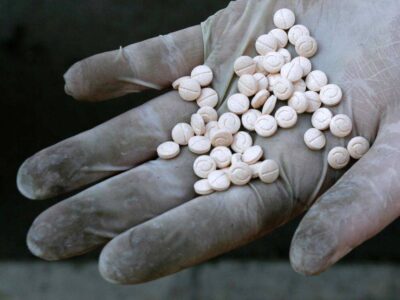
What is the drug Captagon and how is it linked to the Islamic State terrorist group?
It’s potentially the biggest seizure of amphetamines in history — and it allegedly comes from a source that might surprise many people.
Italian police have discovered 14 tonnes of the drug Captagon hidden inside machinery and paper cylinders, on container ships in the port of Salerno.
They say the stimulant drugs were allegedly produced in Syria by the Islamic State (IS) group, and had a street value of about 1 billion euros ($1.6 billion).
Captagon, a brand name for the amphetamine drug fenethylline hydrochloride, was originally marketed as a treatment for conditions like narcolepsy, depression and hyperactivity, but has been banned in most countries since the 1980s.
Counterfeit versions of the drug have remained popular in the Middle East, where its fear-inhibiting and stimulating effects have also proved useful during protracted firefights in war-torn areas — it is not, however, widely used in Europe.
Reports in recent years have suggested that Syria has become a major production area for counterfeit Captagon pills, including by IS, which Italian authorities said was seeking to sell the drugs to fund its militant activities.
So what is a religious extremist terror group doing manufacturing and using illegal drugs, and why would they be trying to export it to Europe, of all places?
For years, Captagon has been know as the “drug of the Jihad” as it has often been found in militant hideouts, including in one used by the terrorists behind the 2015 Bataclan theatre attack that killed 90 people in Paris.
Reports of widespread drug use by IS fighters are also not new, and it’s worth noting that there have been reports of Captagon use on all sides of the Syrian conflict.
In its most recent World Drug Report, the UN Office on Drugs and Crime (UNODC) said counterfeit Captagon production in the Middle East was centred primarily on Syria and Lebanon, where it’s manufactured illicitly for domestic use and export.
This counterfeit version of the drug often contains amphetamine, alongside caffeine and other substances.
Fenethylline, the amphetamine used in the long-banned brand name version, has been a controlled substance for decades now and is subsequently more difficult to obtain, so other amphetamines are often used in the counterfeit version.
Up until the Syrian civil war began in 2011, Bulgaria and other Balkan nations were the main source of counterfeit Captagon pills.
Instability in the region helped drive the manufacture and trafficking of the drug, as it created a lack of control over illicit drug manufacturing, and poor monitoring of the clandestine laboratories where it was being made.
In turn, the UNODC report said trafficking the drugs was “an additional source of income for terrorist and insurgency groups” in the Near and Middle East.
Again, while Italian police have been quick to say they believed this massive shipment of Captagon was manufactured by IS, it is hard to know that for certain.
Italian authorities also gave no indication of how the terror group, which has been weakened significantly in Syria, would have been able to produce the drug in such large quantities, let alone smuggle it into Europe.
All sides in the Syrian conflict have potentially been involved in manufacturing the drug, including the Lebanon-based militant group Hezbollah, which is allied to Syrian President Bashar al-Assad.
There is a large market for counterfeit Captagon pills across the Middle East, but the biggest destinations for the drugs are Saudi Arabia and other Gulf states like the United Arab Emirates, Qatar, Kuwait and Bahrain.
It has also been making its way to Libya and Sudan, according to the UNODC.
Research on drug use in these countries is very limited, so it is not known how widespread abuse of Captagon is in the region, or which demographic groups are the biggest users.
While there has previously been some evidence of counterfeit Captagon pills being trafficked to Europe, this is often just for transit before being forwarded to a destination where it is more widely used, like Saudi Arabia.
Keeping this in mind, the massive shipment seized by Italian authorities raises questions — if Captagon is not widely used in Europe, why smuggle such an immense quantity of the pills into Italy?
Adding to the confusion is the fact that, according to the UNODC, Europe itself is a major source of the precursor chemicals used to make counterfeit Captagon pills — the chemicals are smuggled into Syria via seaports.
Italian police said the coronavirus pandemic, which saw much of Europe go into an extended lockdown, may offer a clue.
They think the lockdowns may have hampered the production of amphetamines in Europe, and local traffickers have had to get the drugs sent over from Syria, where manufacturers have presumably been able to continue producing drugs undisturbed.
Police say they are looking into whether organised crime groups in the Naples region were involved in this shipment — Salerno, where the drugs were seized, is about 50 kilometres south of Naples.
Source: ABC Net





